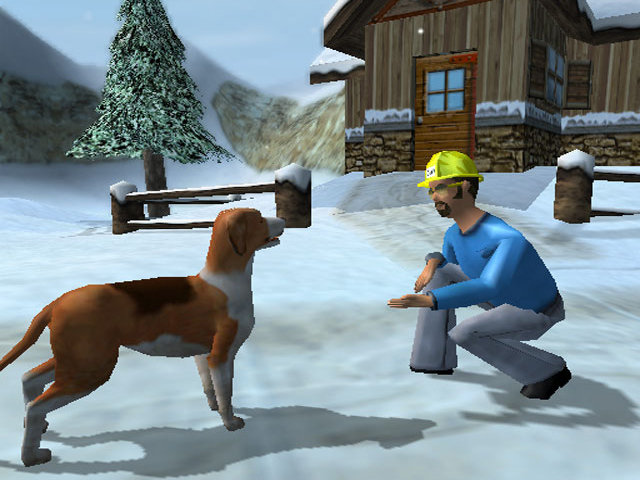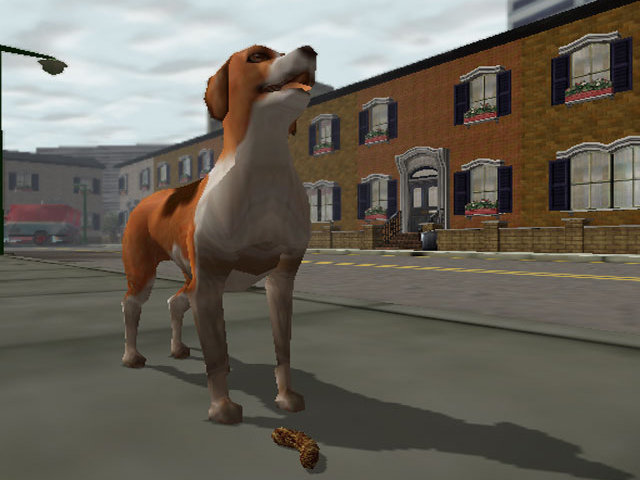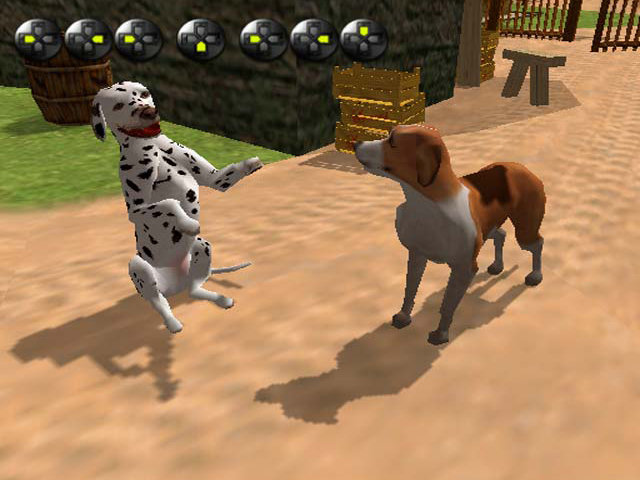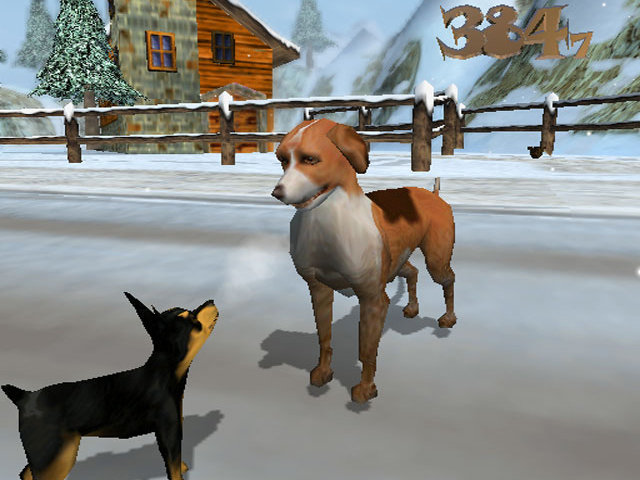Over the past five years, Frontier Developments has built its identity around the kind of classic game franchises and genres that make up the studio's long development history. Elite: Dangerous is an incredibly detailed space sim whose roots predate DOS and Amiga-era gaming. They make tycoon and management games in the vein of Roller Coaster Tycoon, playing to a very particular brand of nostalgia. But in the studio's long history, there is nothing stands out like Dog's Life.
Dog’s Life was sold to press at E3 2004 as "Grand Theft Auto with dogs." It's not an especially good game, but it is transfixing. Its platforming, minigames, and Smellovision are janky and have that familiar "tank control" feeling common to many PS1-era games (unfortunately because it is a PS2 game). Its draw distances are so short the game suffers from a permanent nearsightedness, and its writing and sense of humor are questionable at best. It has the prolific actor Kerry Shale at his most prolific, performing over two dozen characters within the game.
That's a record for video game voice actors, but probably not the kind of record one hopes their game will set. It's all indicative of an under-resourced game from a studio stretched to its limit. It was greeted as such by reviewers, and the game attracted scant attention and affection at its release. You’ve likely only ever seen Dog's Life on YouTube or at AGDQ2018. Yet there is something goofily endearing about it that has kept the game alive within the hearts and minds of its small fan community and the people who worked to develop the game.

Set across four semi-open areas, Dog's Life casts you as Jake, a perpetually flatulent canine who looks like an oddly-proportioned beagle. But a beagle with a cool, irreverent attitude (he farts on everything!), which perhaps betrays the outsized influence that the era's mascot-led platformers had on Frontier as they developed the game. You’re trying to save his paramour, Daisy, from rotund dog catcher Wayne and the scrum-cap wearing Dwayne. All this is tied together by a madcap story of a cat-food personality, Ms. Peaches, wanting to turn dogs into cat food. It's like if a Fancy Feast ad turned into Soylent Green.
Jake was designed specifically to appeal to children, with his heart of rebellious gold, and the story similarly evokes animated favorites like 101 Dalmations. But he never really stood a chance against his contemporaries. Speedrunner Nikolaj “ThaRixer” Sørensen and fan argues the context that inspired Dog's Life also helped seal its fate.
“By 2003 Super Mario Sunshine, Jak II, and Ratchet and Clank 2 were out… there were much more ambitious titles by bigger companies coming out," he said. “[Dog's Life] is basically Mario 64 seven years later. You have the same thing, except Mario is a dog, and the stars are bones, and the movement isn’t as fast and the colors and environments aren’t as colorful.”
While Dog's Life left little impact on gaming’s zeitgeist many of those who worked on it still speak of it fondly. The game’s producer, Frontier’s co-founder, and an artist on Dog’s Life all reminisced about their experiences with Retro Gamer, which resulted in a fun, lovely feature on a largely overlooked game. But it's also one told primarily through rose-tinted lenses by people who remain in leadership positions at Frontier. I spoke to four other members of the Dog's Life team, who had very different roles to play in this project, and whose memories are a bit more ambivalent about a project that was let down by its lack of resources and whose development team was divided between first and second-class citizens.
I reached out to Frontier’s PR but they declined to participate in this story, citing the Retro Gamer piece as their statement on the game's history.
Sergei Lewis had just started as a programmer at Frontier in 2002, becoming a principal programmer in his time there, until he left in 2015. "When I joined, the company [it] was two dozen geeks working in a farmhouse in Longmeadow, near Lode. The building was secluded, separated from the tiny village by a row of very tall conifers. The rooms had fireplaces, there was an Aga [oven] in the kitchen, in which people would make baked potatoes for lunch, and one of the other employees brought his dog to work.” That dog tended to crowd Lewis while he tried to work. “The beast liked to lie under my desk, of all places.”
Lewis joined when Frontier had just moved into Longmeadow. It was a fast and exciting time for Frontier. “The game was part way through development, I was given a workstation, [a] PS2 devkit and a bunch of manuals, and pointed at parts of the code that needed work.”
Money was tight at the time but the studio’s reputation had grown, leading to some oddities in Dog’s Life’s production. The game was originally penned by game designers who had never worked on a script before. They decided the plot should be driven by an unseen cat food monopolist but a promotional deal with Pedigree Dog Food meant that every in-game billboard promoted dog food instead.
“I do not recall Dog’s Life scoring very highly with reviewers at the time, but what I do know is that over the years, I have received emails from fans of the game who cite it as being great to them personally, which is what truly matters at the end of the day isn’t it?”
Optimization was a key difficulty for the team as they worked in genre new to them, on a console they had little experience with. For Lewis, the team's lack of exposure to the PS2 meant grappling with tech they’d never had to use before. Still, Lewis was constantly impressed by the ingenuity of his peers. Reflective water surfaces require intensive calculations even now, but the team managed to emulate them despite the constraints of a PS2 hardware environment they were still figuring out. Lewis was shocked how they pulled it off: “No intricate calculation was involved—the lake [in this case] was simply a hole, and another, upside-down, copy of the surrounding landscape is what I was seeing through it.”
The lack of resources, and Frontier's lack of experience with the PS2 platform, affected the project in other ways. Composer and sound designer of Dog's Life, Alistair Lindsay, filled me in.
“My heart initially sank when I was told that [Frontier] wanted to use realtime midi-based music [on Dog's Life].” Lindsay’s first project was Jetforce Gemini for Rare on the N64, a console hamstrung by its 6MB of ROM, preventing it from streaming in music and making the process much longer and more difficult than the first-time composer anticipated. Lindsay wasn’t keen to work in that fashion again.
“It took a few weeks to convince them that this wasn't the way forward and eventually they let me leave the restrictions of PS2 MIDI, and start mining all the possibilities that streaming pre-recorded audio from a CD-ROM could offer. For example, I could now use real instruments played by a human (me), as well as real synthesizers and good quality reverb and echoes et cetera. All the things that make a record sound like a record, in other words.”
Lindsay underestimated the difficulties of working on a smaller game.“Implementing those assets was tough. In my naïveté I had assumed that all game devs were alike in their level of tech used to get the stuff you made into the game… At Rare the tech was, in hindsight, very advanced… After my move I found myself working with tech that was not in the same league and definitely didn’t fall into the category of being an ‘artist-friendly tool’.”

Workarounds were a constant necessity. In one mission Jake brings a jacket to a little girl by the frozen Lake Miniwahwah. The model couldn’t be animated to put on the flat jacket texture, so they wrote a line for Jake/Kerry. The girl demands that you, a dog, look away while she puts her coat on. The model of the girl is then swapped with different model wearing a jacket texture. The camera just focuses on Jake’s motionless face, looking away, motionless, for several seconds. It's another spectacularly absurd moment in a game full of them.
Finding tricks and hiding things in plain sight are something all games grapple with, especially when ambition is eclipsed by reality. But on the bright side “[It] was actually a great deal of fun; a bit like solving one of those sliding block-puzzles in your head, with the added satisfaction of seeing the game get faster as you went," Lewis recalled.
Lewis and Lindsay may have found joy in their time on Dog’s Life but not everyone did. Former QA tester Liam Robertson began describing his work on Dog's Life by saying,“The life of a tester is pretty thankless! Particularly when we were on slightly above minimum wage and expected to put long hours in for very little reward, and very little praise.”
Roberston worked for Sony at the time, and recalls Dog's Life being in fairly decent shape when it reached his team, despite all its shortcuts. The whole game reminded him of a Tony Hawk game, as it was similarly structured around a series of non-linear sandboxes.

Robertson spent his time “testing characters were animated properly, and dialogue and sound played in sync… Could the challenges be completed? Did collecting the correct amount of bones unlock progression. And of course, did the game crash at any time!” First, he had to play through all of a game where “NPC characters were fairly nonplussed by the dog throwing faecal matter around.” That was the fun part.
According to Robertson, and most other QA testers, playing a game once is fine, but searching for every flaw quickly becomes exhausting. “Testing for clipping is pretty mind numbing. Having to push against every object in the map and all the level boundaries to try to force your way out isn’t much fun… Even for its time, the engine for Dog’s Life was a bit crappy…I can’t put my finger on it, but it just felt like the world was held together quite loosely.”
Every cutscene with the purposely irritating voice acting and mean-spirited caricatures had to be watched and rewatched. Every button mashy QTE or variation on a race had to be won and lost. Every Pedigree Dog Food® Dog Wash had to be entered and reentered. It all had to be noted and re-noted, it’s not an easy job, it takes patience and analytical skill, but often you’re not treated as an equal co-worker. Certainly not if you're external QA like Robertson was.
“The way games were developed back then was very much in a ‘waterfall style’ anyway. That is to say the games plot and core features, the levels would all have been locked down by the time it got to us. And testers were certainly not respected in perhaps the same way they are now. If you wanted to offer up any suggestions on gameplay or story they would probably have been dismissed out of hand, or at least the insinuation would have been ‘stay in your lane’. ...Particularly if we’d pointed out that the tone of the final level, with its rusty looking meat grinding machines, felt a bit at odds with what was quite obviously a game aimed not at teens, but younger children."
On the other hand, that kind of outsider perspective might have been useful when it came to Dog's Life. To Robertson and his colleagues, it was clear as day how weird and disconcerting Dog's Life could be.
The final level takes place in a location ripped out of Silent Hill or Resident Evil, a red-skied hellscape and industrial lab. Inside this industrial nightmare of a cat food cannery, where the game changes to a fixed camera perspective, you save Daisy from death... By farting in Ms. Peaches face.This knocks her back into a grinder and canning machine in a sequence that at the very least lacks viscera, though it pointedly shows the machine's bloody saws and grinders.
The bizarre tonal shifts between cheery childishness and violent horror, rather than detracting from Dog's Life, probably contribute to its weird charm. Lindsay's soundtrack, while it may have been a struggle to produce using Frontier's lackluster tools, provided the game with much of its character.
Lazily looping guitar twangs suit the middle-American road-trip vibe to a tee. Living in rural areas most of his life and drawing inspiration from his own dog, a Lurcher fittingly named Django, Lindsay said he felt his way into the “emotional narrative of the game’s story."
“After all that is always the most important thing- to make sure what you do as a composer supports the story and where possible actually enhances the 'emotional topography' for the viewer/player to immerse themselves in.”
Lindsay's only explanation for that final level's chilling score was, “I think it is probably that the scary/darker tone was a game-design decision that was passed on to me as composer as part of the brief for that level...I may have overdid it.” Alistair went on to create the eerie soundscape for the nuclear war sim Defcon, though I still think the pound’s music is more haunting.

Dog's Life reception was muted to say the least. Still, Lindsay finds meaning in the memories people have of the game. “I do not recall Dog’s Life scoring very highly with reviewers at the time, but what I do know is that over the years, I have received emails from fans of the game who cite it as being great to them personally, which is what truly matters at the end of the day isn’t it?”
The lead QA tester on Dog’s Life, Carl McKane, doesn’t quite agree with Lindsay. He no longer works in the game industry, and does not look back on Dog's Life with much affection. “We were underpaid and underrated within the industry. We were all gamers but our opinions weren't listened to.”
As lead QA tester at Sony, and a dedicated worker, McKane had to raise issues with the game constant fecal humor. Robertson and much of the young QA team thought it was hilarious when they discovered the ability for Jake toss his waste at a NPC or into a pram, but McKane felt strongly that the game was already too crude and tried to reduce it the games gross-out factor where possible. “The programmers put that in… I felt the defecating on command was ridiculous and disgusting so I suggested the amendment to Jake being able to defecate on command. If he has already defecated then subsequent attempts produce flatulence until Jake has eaten something.”
Dog’s Life could have been a disposable, forgettable, cynical product but the passion of its creators means it’s more. Many of its creators and contributors have a complicated relationship with the game: They put as much time and effort into this curiosity as any studio puts into any game Now Dog’s Life is often recalled as little more than an obscure internet joke.
At the very least, working on it provided some good lessons both about game development, and about life.
As McKane said, “A dog farting is funny but shitting isn’t.”
from VICE https://ift.tt/2Kr4D3A
via cheap web hosting
No comments:
Post a Comment